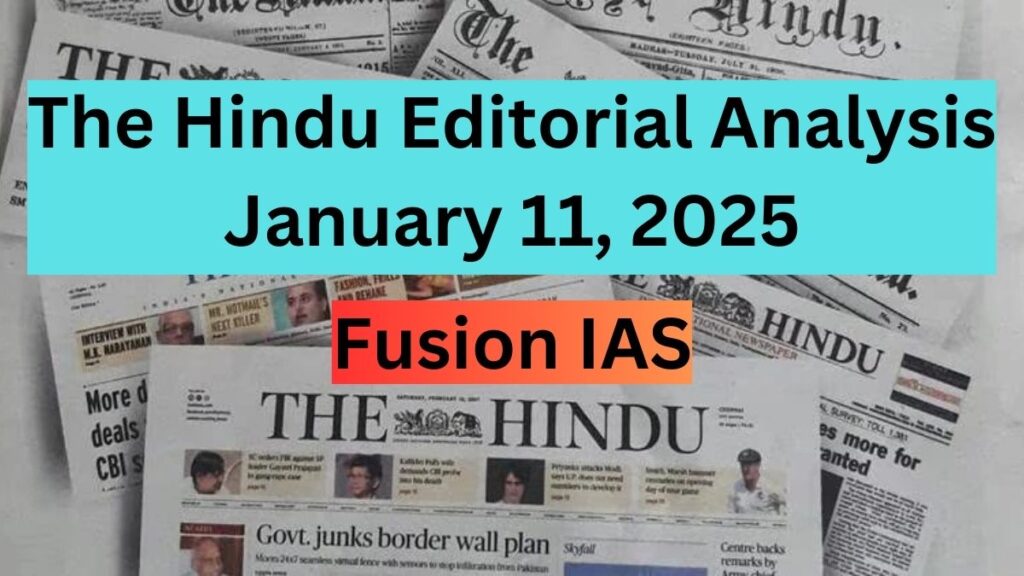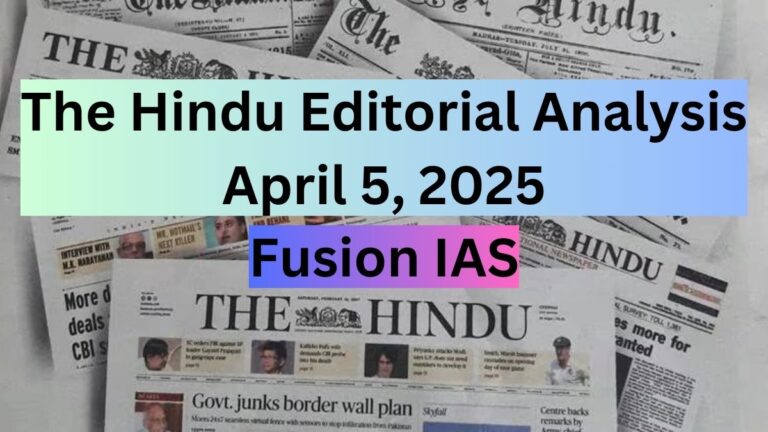
The Hindu editorials are a crucial resource for understanding key national and international issues. This analysis simplifies complex topics, highlights key points, and offers critical insights, making it an essential tool for competitive exam preparation like UPSC CSE and developing a well-rounded perspective on current affairs.
1. India’s journey so far on the AI military bandwagon
- AI in India’s Defence: India has started integrating AI into its military systems, with initiatives such as the Indrajaal autonomous drone security system. It has attracted foreign investments, including Microsoft’s $3 billion commitment.
- Statements from Officials: Defence Minister Rajnath Singh emphasized AI’s potential to revolutionize military operations, including predictive analytics and autonomous decision-making.
- Hurdles to AI Adoption:
- Digitisation and Funding: Lack of digitised data for training AI systems and high costs of data centres pose challenges.
- Legacy Hardware: India is prioritizing the replacement of outdated military hardware, diverting resources from AI development.
- Fragmented AI Policies: India’s AI policies are incomplete, with vague deployment guidelines. Existing frameworks like the National Strategy for AI lack specifics for military AI.
- Global AI Adoption: Countries like Israel and China have advanced military AI capabilities. India needs a clearer vision and policy to accelerate AI development in its military and catch up with global advancements.
- Challenges Specific to India:
- Siloed Armed Forces: The separation between the Indian Army, Navy, and Air Force creates barriers to interoperability and joint operations.
- Overreliance on PSUs: The traditional reliance on public sector units (PSUs) for defence production limits access to high-quality, advanced systems. Public-private partnerships (PPPs) or private sector involvement is needed for more efficient procurement.
- Strategic and Policy Changes Needed: India must address the siloed nature of its military, strengthen AI policies, and promote private sector participation to overcome these challenges. International collaboration will help accelerate AI adoption.
Conclusion: A cohesive strategy, coupled with systemic reforms, is essential for India to effectively leverage AI in its military, ensuring both technological advancement and ethical deployment.
2. Forging leadership with India’s youth power
- National Youth Festival: Celebrated annually on January 12, coinciding with Swami Vivekananda’s birth anniversary, to inspire and empower India’s youth.
- Viksit Bharat Young Leaders Dialogue:
- A program launched to engage India’s youth in the nation’s development journey.
- Focuses on harnessing youth potential for a developed India (Viksit Bharat).
- Provides a platform for youth to engage in discussions, exchange ideas, and collaborate on national challenges.
- Competition Structure:
- Stage 1: Digital quiz on India’s achievements, challenges, and development goals.
- Stage 2: Essay and blog writing on themes like “Tech for Viksit Bharat” and “Empowering Youth for Viksit Bharat”.
- Stage 3: Presentation of innovative ideas through pitch decks at the state level.
- Stage 4: National Championship at Bharat Mandapam in New Delhi, where teams pitch solutions to the Prime Minister.
- Theme of National Youth Festival 2025:
- Youth for Sustainable Development: Aligning with India’s commitment to the SDGs, with workshops, seminars, and cultural activities promoting a sustainable and inclusive future.
- Tech for Good and Innovation: Emphasis on technology and innovation to achieve national goals.
- Virtual Participation: Expanded digital platforms enabling youth from remote areas to participate in workshops, discussions, and talent showcases.
- Festival Features:
- Leadership and Innovation: Workshops on youth leadership, digital entrepreneurship, and sustainable living.
- Cultural Programs: Celebrating India’s cultural heritage through music, dance, and folk arts.
- Tech and Innovation Showcases: Exhibitions by young innovators solving real-world problems in sectors like health, education, agriculture, and urban development.
- Engagement with Leaders: Direct interaction with leaders from government, business, and academia.
- Youth Recognition: Awards for exceptional leadership, innovation, and service to inspire others.
- Role of MY Bharat:
- Mera Yuva Bharat (MY Bharat) facilitates the digital integration and engagement of youth, supporting youth-led initiatives and ensuring alignment with national development goals.
- Provides mentorship, resources, and opportunities to empower youth.
- Youth as India’s Asset: India’s youth is seen as the driving force behind the nation’s transformation. Initiatives like the Viksit Bharat Young Leaders Dialogue aim to channel their energy, creativity, and leadership for India’s development.
- Swami Vivekananda’s Influence: The initiative reflects Vivekananda’s belief in the power of youth energy to transform India into a global leader.
Conclusion: India’s future lies in the hands of its youth, and initiatives like the Viksit Bharat Young Leaders Dialogue play a pivotal role in mobilizing youth for the nation’s growth.
3. Chasing truce: On the U.S. and talks between Israel and Hamas
- U.S. President Joe Biden’s Remarks: Biden expressed confidence in securing a ceasefire and hostage deal between Israel and Hamas, highlighting rare progress in negotiations to end the 15-month-long war.
- Conflicting Narratives:
- Biden attributes Hamas as the primary obstacle to a deal.
- Qatari and Egyptian officials involved in the talks cite Israeli Prime Minister Benjamin Netanyahu’s refusal to accept anything more than a temporary ceasefire as the main hurdle.
- Netanyahu’s Position:
- Netanyahu is more focused on his government’s survival than on ending the war.
- While accepting a temporary ceasefire in return for hostages, he is unwilling to agree to a permanent ceasefire.
- Hamas’ Demands: Hamas insists on a permanent ceasefire, fearing Israel will resume fighting once hostages are released.
- Humanitarian Crisis in Gaza:
- Over two million people in Gaza face dire conditions, with shortages of food, water, medicine, and electricity.
- Israeli strikes have led to the deaths of 46,000 Palestinians, with most of Gaza’s population living in tent cities.
- Israel’s Objectives and Outcome:
- Israel’s original goals included destroying Hamas, securing hostages’ release, and ensuring long-term security.
- After 15 months, Israel has destroyed much of Hamas’ military infrastructure but the group has survived as an insurgency.
- Hostage releases have been minimal, and long-term security risks persist.
- Regional and International Implications:
- Israel faces missile and drone attacks from the Houthis of Yemen.
- The country is facing international isolation, with the International Court of Justice hearing a genocide case and the International Criminal Court issuing arrest warrants for Israeli leaders.
- Rights organizations have accused Israel of genocide.
- Call for Ending the War:
- The article criticizes Israel’s inability to achieve its objectives and its disregard for international law.
- It calls for Netanyahu to leave Gaza in exchange for the release of all hostages to end the war.
4. Local power: On Tamil Nadu government’s move
- Government Decision: Instead of holding elections to rural local bodies (RLBs) in Tamil Nadu, the state government has appointed special officers for several districts where elections were due on January 5, 2025.
- Reason for Delay:
- The government cited the ongoing re-organisation and delimitation of wards of rural and urban local bodies as a reason for delaying the elections.
- The delimitation and establishment of quotas for women, Scheduled Castes (SCs), and Scheduled Tribes (STs) are considered prerequisites for holding polls.
- Expansion of Local Bodies:
- The government plans to merge at least 140 village panchayats with municipal corporations and expand the limits of municipal corporations, municipalities, and town panchayats by including adjoining village panchayats.
- This is in response to rapid urbanisation in areas near major cities like Chennai and Coimbatore.
- Supreme Court Ruling:
- In the Suresh Mahajan vs State of Madhya Pradesh case, the Supreme Court held that delimitation should not delay elections, emphasizing that elections should be held within the five-year term of outgoing bodies.
- The Court also stated that delimitation should be a continuous exercise and should start well in advance to ensure timely elections.
- Opposition to Reorganisation:
- Some residents are opposing the reorganisation, particularly the merger of village panchayats with urban local bodies, fearing it could impact rural development schemes like the Mahatma Gandhi National Rural Employment Guarantee Act (MGNREGA).
- Wider Context:
- Tamil Nadu is not alone in delaying local body elections; other major cities like Mumbai and Bengaluru have also faced similar delays in holding timely elections.
- Significance of Local Bodies:
- Local self-governments play a crucial role in the democratic structure and have a significant impact on people’s lives, despite shortcomings in their functioning. The importance of timely elections and democratic processes at the local level is emphasized.
Disclaimer:
This analysis is based on the editorial content published in The Hindu and is intended solely for informational and educational purposes. The views, opinions, and interpretations expressed herein are those of the author of original article. Readers are encouraged to refer to the original article for complete context and to exercise their own judgment while interpreting the analysis. The analysis does not constitute professional advice or endorsement of any political, economic, or social perspective.
Follow Fusion IAS


